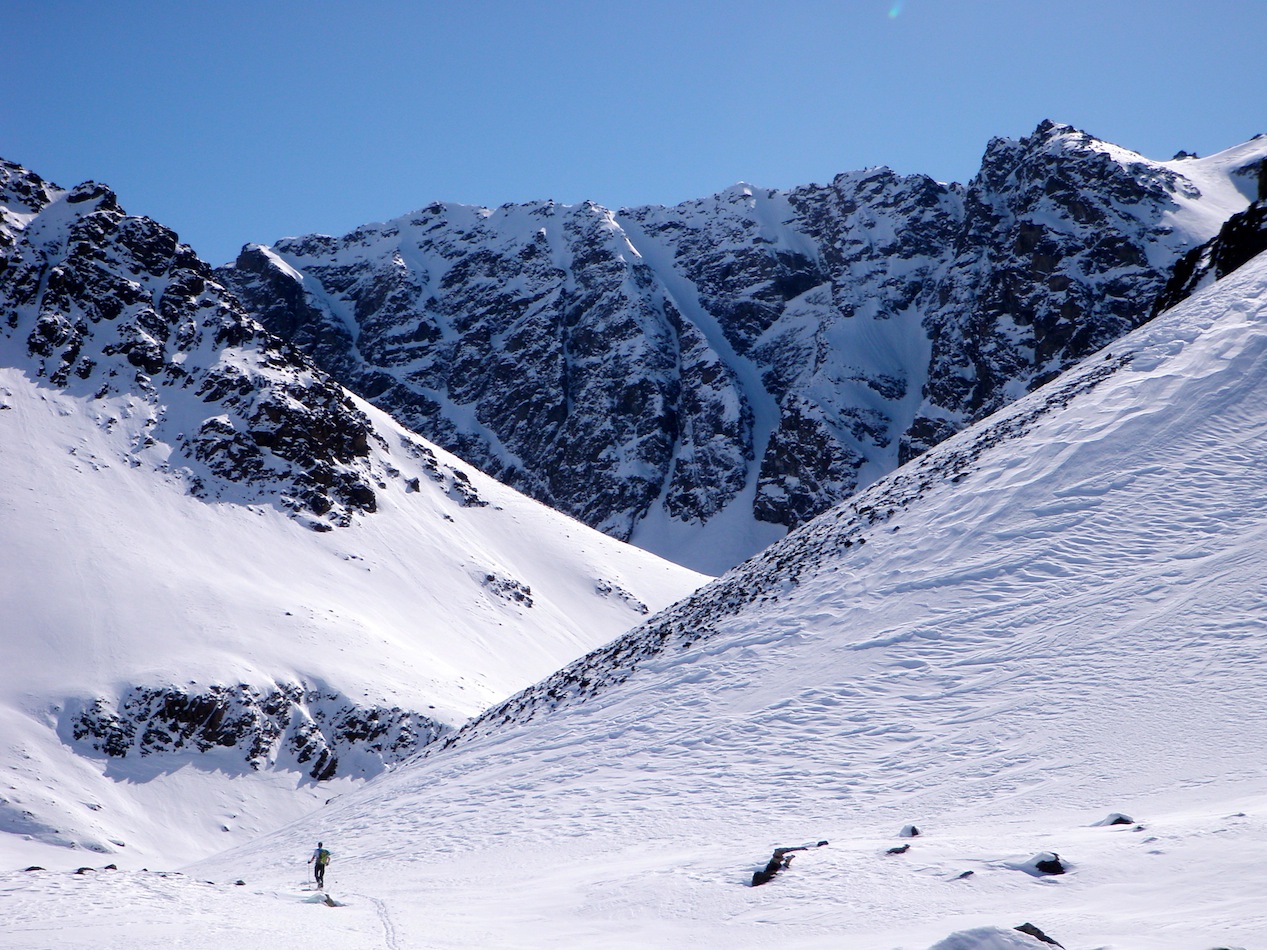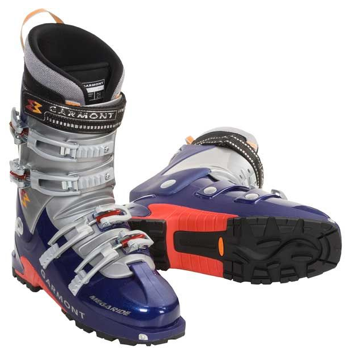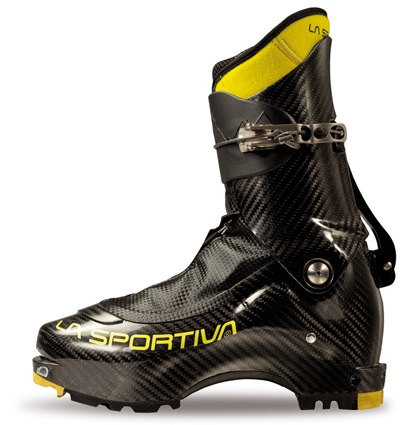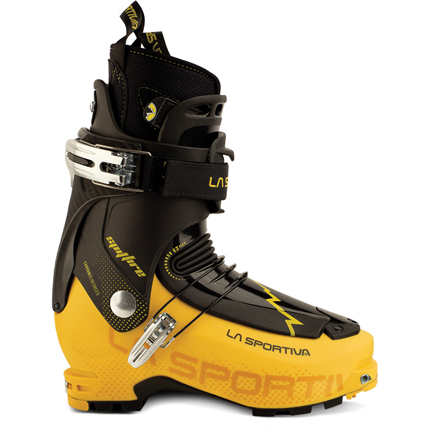 North Couloir, Tanaina Peak, Chugach, AK - photo: Mat BruntonThe insane run of high pressure finally comes to an end today and, as the clouds moved in, I realized I would finally get to write something. Some good days have been had and I’ll share those in the next few days but first I wanted to get a review out on my Sportiva Spitfire boots.
North Couloir, Tanaina Peak, Chugach, AK - photo: Mat BruntonThe insane run of high pressure finally comes to an end today and, as the clouds moved in, I realized I would finally get to write something. Some good days have been had and I’ll share those in the next few days but first I wanted to get a review out on my Sportiva Spitfire boots.
History
In the last decade, ski touring boots have seen major changes. My first pair of touring boots back in the early 90’s were a pair of Raichle something-or-others that were damn heavy. Hard to even find in this country. Similar offerings from Nordica and Lowa all tipped the scales over 9 pounds. Ugggh.
My first exposure to lighter boots came from Garmont in the early 2000’s. I was still on Fritschi bindings but at least my boots were way lighter. When I moved to Jackson on a full-time basis and truly became a die-hard skier influenced by fellow guides Doug Coombs, Mark Newcomb, Hans Johnstone, etc. the gear world opened up to me. I was finally privy to the inner circle of some of the sports trend setters. Not that I was skiing with these guys but at least I could listen in during sessions at the climbing gym.
 I got a pair of Garmont Mega Rides that year, a boot popular with all those guys. Dynafit had some boots out there, too, but I think the downhill performance was compromised by their weight saving tactics. I skied the piss out of my Megas and nearly wore through the heel pocket of the liner. I did this not skiing steep lines but lapping powder runs like most Jackson skiers.
I got a pair of Garmont Mega Rides that year, a boot popular with all those guys. Dynafit had some boots out there, too, but I think the downhill performance was compromised by their weight saving tactics. I skied the piss out of my Megas and nearly wore through the heel pocket of the liner. I did this not skiing steep lines but lapping powder runs like most Jackson skiers.
I caught the skimo racing bug in 2007 and that changed my feelings toward gear significantly. I wanted light and nimble. I started caring less about skiing performance and more about ground covered. I made a bunch of compromises in order to get more vert in less time. About the time Black Diamond decided in was “all about the down” my friends and I decided it was all about the up. I traded my Mega Rides in for a pair of Scarpa F1s. I sold my BD Verdicts and my fattest “powder” ski was 75mm under foot Trab Free Rando. Laughable, I know. But, the generally perfect Teton powder allowed more than adequate fun on little skis.
I was focused on racing so I spent a lot of time on race gear in the back country. I think this obsession even strained my relationship with former partner, Steve Romeo. Rando leveraged himself into BD’s good graces and couldn’t really deal with swapping trail breaking duties with me on Trab World Cups (65mm underfoot) while he motored on his Megawatts. We had a lot of good days together before my switch and I remember them fondly but we sort of broke up after our final outing on the Banana Couloir on Prospectors. Style can do that.
When Dynafit introduced the TLT 5 , my whole world changed. I could now have a seriously light boot that still offered downhill performance. This boot was true to the hype. It was a game changer. Skimo race design had finally trickled down to touring. I knew others would follow. I bought it as my race boot but used it everywhere. It was that good.
Sportiva
 Sportiva Stratos EVOSportiva entered the ski game a few years ago. Given their sexy Italian roots, I was curious to see what they would bring to the boot market. They snapped some heads around with the Stratos EVO. This $3,000 carbon fiber work of art is a thing of beauty to behold. It’s certainly out of reach of most racers’ budgets but that doesn’t keep all who fondle its 663 grams (with race liner) from coveting it.
Sportiva Stratos EVOSportiva entered the ski game a few years ago. Given their sexy Italian roots, I was curious to see what they would bring to the boot market. They snapped some heads around with the Stratos EVO. This $3,000 carbon fiber work of art is a thing of beauty to behold. It’s certainly out of reach of most racers’ budgets but that doesn’t keep all who fondle its 663 grams (with race liner) from coveting it.
 Sportiva SpitfireNext on tap from Sportiva was their answer to the TLT 5, the Spitfire. This is a competitively priced, reasonably light boot with some unique features I found intriguing. With my TLTs on their third season, I went looking for a replacement.
Sportiva SpitfireNext on tap from Sportiva was their answer to the TLT 5, the Spitfire. This is a competitively priced, reasonably light boot with some unique features I found intriguing. With my TLTs on their third season, I went looking for a replacement.
Disclaimer
Although my efforts on this site garner some favor with elements of the ski industry, I rarely get anything for free. But I do get some deals on what I buy in return for exposure like this. I still want to be as even-handed as possible when it comes to reviews but you may accuse me of some bias. Caveat emptor.
Review
I got my Spitfires almost 2 months ago. After a shakedown run on Peak 3 in the Chugach front range above Anchorage, I took them as my sole boot for a 10 day trip to the Tetons. I’ve since had them out on several other outings in the Talkeetnas and Kenai mountains. They were with me for a rare descent of Break Neck Road on Peak 10,696 and the Otter Body Face on the Grand Teton. Here’s what I think. Break Neck Road - North Face, Peak 10,696, GTNP
Break Neck Road - North Face, Peak 10,696, GTNP
Fit
I got them in my usual 28 size and they were true to that. They come with a minimal Palau liner. I skied them one day out of the box and had some pressure issues and they felt a little short. But once I molded the liners, length was fine. I ended up with some pressure issues over my right instep that I have not been able to fix with a remold. I’ve had this with other boots. I think a bit more volume with a different liner would fix this but there are other issues with this (see below).
Sole length on my 28s is 307mm, the same as my TLTs. This made race binding compatibility fine. No remounting required on fixed binding set ups.
Weight
My size 28 Spitfire shell tips the scale at 1056 grams. Compare this to the TLT Performance at 908 grams. I currently ski my TLTs with an Intuition Pro Tour liner which goes at 321 grams with foot bed. Spitfire’s Palau liner goes for 246 grams vs TLT stock liner at 238 grams, both with foot beds in. The bottom line is that with stock configurations, the Spitfires are 156 grams heavier.
Going up
In tour mode, the boot flexes well. There is little resistance to forward ankle flex as all of the rigidity comes from the cuff when locked. This is nice. The lower buckle pressure point can be moved up or down the top of the foot with the use of a clever feature on the outer tongue. I still had some issues with my right foot but found if I left this loose or moved the cable to the front most position, most of this problem went away. There are no issues with a removable tongue ala Dynafit. This is a serious upgrade. Better moisture protection, too.
One of my big issues with the Spitfire is the sole rocker. For whatever reason the designers felt that an extreme amount of rocker would be a good thing. Not sure why. A ski boot is rigid and stuck in a binding. Rocker is irrelevant, in my opinion. It might help walking to the coffee shop before heading out but that’s about it.Sole rocker comparo - Spitfire vs. TLT 5
What this rocker does screw up is crampon compatibility and boot pack performance. I couldn't make my Petzl Dartwin crampons fit securely. I discussed this problem with Dane Burns at Coldthistle and he lamented the same problem with several attempts using different brands. I even swapped out some Grivel bails without luck. My Grivel Haute Route crampons fit fine but I would not climb serious ice in them.
Petzl Dartwin on Dynafit TLT 5. A fit that warms my heart.
Petzl Dartwin on Sportiva Spitfire. A fit that induces fear.Now, some could argue that this is a ski boot and ice climbing performance is a non-issue. But I would counter that many modern ski mountaineering lines require some technical climbing, at least the ones I’m attracted to. So, I think a ski mountaineering boot should be up to the task. This is even more significant in a competitive market since many climbers feel that the Dynafit TLT 5 is a sweet ice climbing boot in its own right. That’s saying a lot.
From my observation, the issue with the Spitfire here is the radius of the rocker and not so much the amount of rocker. It’s so curved at the front half of the fore foot that most longer semi automatic crampon bodies simply can’t make the turn. The long and short of it.The bails just don’t line up with the toe welt very well. My Grivel Haute Routes are a light touring crampon and are quite short on the front half which allows them to turn the corner. I climbed the Owen Spaulding route on the Grand Teton recently and they worked great. But on steeper ice, I would be out of luck. The idea of having a crampon pop off my boot while soloing steep ice makes me want to vomit.
Although less serious, the rocker also makes booting without crampons a little slippery. The rocker encourages less secure toe purchase than a flatter sole. This isn’t a problem with spikes on but something like the Teton Pass Glory boot pack would be annoying.
Downward
The first thing I like about Spitfire’s downhill performance is the cuff locking mechanism. Instead of a direct peg-in-a-hole affair like Dynafit uses, Sportiva has come up with a rotating catch mechanism that is protected from ice build up with a clever housing set up.
For guys like me who like to modify our pants to go over these buckle systems, it also means one less hole in our cuffs. Nice.
Once latched, the cuff feel is stiff. Compared to my TLTs without tongue or power strap, which is the only way I ski them, the Spitfire is stiffer. I like this. There is still some give in the lower shell to offer some flex progression. I also like not having any power strap (this can be added) or removable tongue to mess around with.
Sportiva Spitfire with optional rear spoiler attached (R)Forward lean can be adjusted to three levels using removable plates for the cuff mechanism. This requires removing two screws and changing out the plates provided. Additional rear support can be added using a spoiler also provided with the boots. Attaching the spoiler and powerstrap adds 44 grams.
Liner issues
At the suggestion of a friend, I put an Intuition Pro Tour liner into my TLTs last year to excellent effect. It took up some slop and increased downhill performance. It also added some warmth which was welcomed during some -20 degree mornings this winter. I was hoping to do the same with my Spitfires.
Unfortunately, there's some limitation as to how big a liner the cuff will accept. The issue is that, with a thicker liner, the two overlapping cuff pieces will switch positions and compromise cuff closure when switching to downhill mode. This would require undoing the cuff, rearranging the pieces and then locking the cuff down. Not completely out of the question but pretty annoying. The cuff flaps would have to be a couple of centimeters longer to prevent this.
One last issue worth mentioning is the quality of the Spitfire tech fittings at the toe. They're smaller than the ones Dynafit uses. This is a small point but the size makes clicking in slightly trickier, expecially in steep terrain.
Verdict
Overall, I’d say this is an excellent ski touring boot. For lapping powder and cruising the backcountry on long tours requiring a light set up it’s an excellent choice. But as a ski mountaineering boot, there are a few things that need working out before I can make it my go to boot for technical lines.
Update
The comment at the bottom led me to do some quick research on the Petzl Lynx crampon. Sounds like it might just be the ticket. I will score a pair and report back. For now, have a look at this video and see what you think. There is also a typically (and almost painfully <heh>) in-depth review by Dane Burns on Cold Thistle. Good stuff. Not sure I should write anything on it since Dane hammers it out way better than I could.